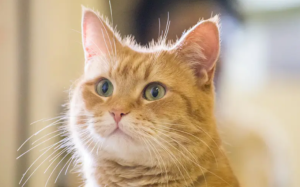When it comes to cats, our common stereotypes often label them as “aloof,” “arrogant,” or indifferent towards humans. However, recent findings published in Scientific Reports suggest otherwise. Scientists have discovered that cats can associate spoken words with images on a screen. What’s more surprising is that this ability of kittens may even surpass that of human babies in certain ways.Through their experiments, the scientists found that cats, without any special training, can seemingly pick up basic human language skills simply by hearing us talk. So, while cats may appear distant and cold, they could very well be secretly listening to our conversations!
-
A “Kitten Edition” Word Test
This recent study was conducted by cognitive scientists Saho Takagi from the University of Azabu and her research team. They tested 31 adult pet cats, including 23 cats waiting for adoption at a cat café, with a word test designed for human infants. Each kitten was placed in front of a laptop, and when the fictional word “keraru” was played, a blue unicorn appeared on the screen. When the word “parumo” was played, a red sun appeared. The researchers repeated this process with the cats until they seemed to lose interest—measured by a 50% reduction in eye contact with the screen.Next, the research team gave the cats a short break and then played the images again. However, this time, there was a “live incident”: half of the images were paired with the “incorrect” audio—”keraru” was paired with the sun, and “parumo” was paired with the unicorn. Takagi explained that the cats were clearly confused; when they heard the mismatched words, they spent an average of 33% more time looking at the screen. This indicated that they had learned to associate the original words with the images.”Some cats even stared at the screen with dilated pupils under the ‘switch’ condition,” she said. “It was so adorable to see them so engaged in the experiment.” Surprisingly, most cats learned to associate each word with an image after just two 9-second lessons. In comparison, most 14-month-old human babies need four 15-second sessions, listening to each word seven times, not four. However, Janet Walker, the scientist who designed the original infant word test, also pointed out that the cat version of the word test differs from the infant version in several ways. Cats heard their owners exaggerate the sounds of the three-syllable words, while babies heard unfamiliar voices using various intonations to say one-syllable words.Through this experiment, scientists discovered that cats don’t require special training. Simply by hearing us talk, they seem to pick up basic human language skills. “In everyday life, cats pay more attention to what we say than we realize—and they try to understand us,” Takagi said.
-
Kittens Who Understand Human Speech
Over the past five years, scientists have learned much about how cats respond to human language. In 2019, a research team in Tokyo showed that cats “know” their names—try saying four words that sound similar to your cat’s name, spaced about 15 seconds apart, and then call out your cat’s real name. If the cat swivels its ears or raises its head, it’s likely recognized its name. In 2022, Takagi and other researchers proved that domestic cats can “recognize” the names of their cat friends. In one set of experiments, the researchers played the names of the cats’ housemates and displayed photos of those friends on the screen. In another set, the names were paired with photos of unfamiliar cats. The results showed that the pet cats noticed the mismatch between their friends’ names and faces, spending more time staring at the screen. This means that when domestic kittens see a photo of a friend, they can associate the friend’s name with their face.However, in the same test, cats from the cat café showed no significant difference in their reactions. The researchers then conducted another test, using the same method with photos and names to see if the cats could match the names and faces of human family members. The final results showed that not all cats spent more time looking at the screen when the names didn’t match the photos, but cats living with family members for longer showed the most prolonged attention. Moreover, the number of family members also affected their response: the more family members there were, the longer the cat stared at the monitor when the names and faces didn’t match. These results suggest that cats may also learn human names by observing interactions between people.

-
Fascinating Facts About Kittens
①Domestic Cats Have Not Been Fully Tamed.Despite being domesticated, domestic cats are not as different from their wild ancestors as one might think. While domesticated animals like dogs have significant genetic differences from their wild counterparts, cats and wildcats share very few differences in their genome. Studies confirm this viewpoint. Domestic cats are genetically similar to wildcats, with only a few minor variations. However, domestic cats are generally friendlier, or at least more tolerant, of humans. Research shows that kittens who interact with humans at 4 to 8 weeks of age are more likely to grow up as well-adjusted pets, while kittens who are first exposed to humans at 8 weeks tend to be more reserved, and those who meet humans at 10 weeks are rarely friendly. This means that if a cat doesn’t receive human care during its early development, it will likely remain wild, and this cannot be reversed. So, it’s best to start bonding with your kitten early on!
②Two-Thirds of Their Lives Are Spent SleepingCats spend two-thirds of their lives sleeping. However, unlike humans, their sleep sessions are typically short—usually no more than an hour—but they take many naps throughout the day. That’s why you often find your kitten sleeping anywhere and everywhere!
③They Can Squeeze Through Surprisingly Small Gaps.For cats, if their head can fit through, their body can usually follow. Studies show that cats are more sensitive to the height of an opening than its width. When the opening is more than 20 cm tall, almost all cats will attempt to pass through, regardless of its width. No wonder your cat loves to squeeze through curtains!
④Night Vision Is Six Times Better Than Humans.A cat’s night vision is six times better than that of humans. In complete darkness, a cat can move through the space with ease, just like walking on a moonlit night. They can accurately distinguish the positions of furniture like tables, chairs, and sofas. Cats have a special layer in their eyes that reflects light back onto the retina, increasing the amount of light they can see. That’s why you often see your cat’s eyes shining brightly in the dark.
⑤They Have a Much Larger “Vocabulary” Than Dogs.Studies have shown that cats have a larger “vocabulary” than dogs. When two cats meet, they can make over 50 different sounds and tones, with pitch variations that express a wide range of emotions. Compared to other animals, cats are much better at using their vocalizations and body language to communicate their feelings to both humans and other cats.
Smart and independent, cats bring endless joy to our lives. What have you experienced during your time as a cat owner? What is the trait you love most about your cat? Feel free to share your thoughts in the comments section.





